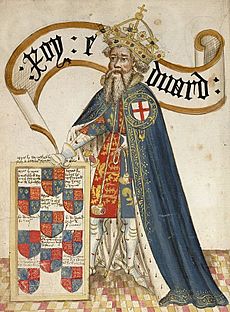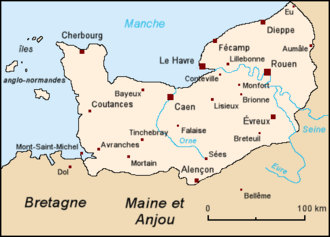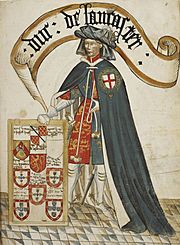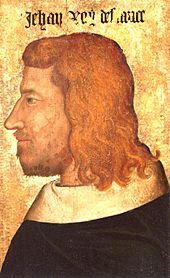Lancaster's Normandy chevauchée of 1356 facts for kids
Quick facts for kids Lancaster's Normandy chevauchée of 1356 |
|||||
|---|---|---|---|---|---|
| Part of the Edwardian Phase of the Hundred Years' War | |||||
|
|||||
| Belligerents | |||||
| Commanders and leaders | |||||
| Strength | |||||
| 2,300–4,000 | Unknown but very large | ||||
| Casualties and losses | |||||
| Few | Unknown | ||||
Lancaster's chevauchée (pronounced she-vo-SHAY) of 1356 was a large military raid by English forces in northern France. It was led by Henry, Duke of Lancaster. This raid was part of the Hundred Years' War and took place from June 22 to July 13, 1356.
During the raid, the English army moved quickly, burning and taking supplies from French lands. King John II of France chased them with a much larger army. However, King John could not force the English into a big battle.
The English helped two friendly castles that were under attack. They also captured and looted the important town of Verneuil-sur-Avre. The raid caused a lot of damage to France and helped England make new allies. It also kept the French king busy while England prepared for another big raid in the south.
Contents
Why the Raid Happened

For a long time, English kings also owned lands in France. This meant they were vassals (like tenants) to the French kings. In 1337, Philip VI of France decided to take back these lands from Edward III of England. This started the Hundred Years' War, which lasted for 116 years.
In 1346, Edward III led an army into France. They won a big victory at the Battle of Crécy. Then, they captured the important port of Calais. After this, both sides were tired and low on money. They agreed to a temporary stop in fighting called the Truce of Calais. This truce lasted for several years.
By 1355, the truce was ending, and both sides knew a full war would begin again. Edward III planned attacks in both northern and southern France. The French king, John II, tried to prepare his towns and gather an army.
Meanwhile, King John II was having problems with some powerful French nobles in Normandy. He believed they were working against him. On April 5, 1356, King John arrested ten of these nobles, including Charles II of Navarre, who owned a lot of land in Normandy. Four of them were quickly executed.
The nobles who were not arrested asked Edward III for help. They also asked Charles of Navarre's brother, Louis, to send troops from Navarre. This created a chance for England to get involved in Normandy.
The Raid Begins
After the arrests, King John's army took control of most of Normandy. They began attacking castles that refused to surrender. King John's son, Charles, led the attacks on these rebel strongholds. One important castle was at Pont-Audemer, which was holding out against the French.
The Norman nobles who supported Charles of Navarre made an agreement with Edward III. Edward had planned to send an army to Brittany, another part of France. But he changed his mind and sent the army to Normandy instead, to help his new allies.
On June 1, 1356, an English force sailed from England to the beaches of the Cotentin Peninsula in north-west Normandy. This was the same place where the English had landed ten years earlier. Horses needed a few days to rest after the sea journey.
On June 18, Duke Henry of Lancaster arrived with more soldiers. His army grew to about 500 knights and 800 archers. They were joined by 200 Norman soldiers led by Philip of Navarre. Another 800 English soldiers from Brittany also joined them. In total, Lancaster had about 2,300 men, possibly more as they gained local support.
The Journey Out
Lancaster's main goal was to help the castles that were under French attack. These included Pont-Audemer and Breteuil. On June 22, the English army began its march. They moved quickly, as all the soldiers were mounted on horses.
As they rode, they followed the usual chevauchée style. They looted and burned villages and towns that were easy to capture. Stronger castles were simply bypassed. Small groups of soldiers spread out from the main army, causing damage over a wide area. Lancaster was ready to fight a big battle if needed, but he wasn't actively looking for one.
On June 24, the English headed south and then turned east. They burned their way through western Normandy. Four days after leaving their starting point, they reached Pont-Audemer. The French army besieging the town quickly fled when they heard Lancaster was coming. They left behind their equipment. The English spent two days bringing supplies into the town and fixing the damage done by the French.
On July 2, Lancaster marched south again. On July 4, he captured and burned the town of Conches-en-Ouche. The next day, he reached Breteuil. The French besiegers had already left. Lancaster's men resupplied the town so it could hold out for another year.
Meanwhile, King John had gathered a large French army. He thought Lancaster was heading for Rouen, so he moved his army there. But when he realized Lancaster was moving south, he followed. Just a few miles from Breteuil was the rich town of Verneuil-sur-Avre. The English captured Verneuil on July 4. They looted it and took many valuable prisoners.
The richest people in Verneuil had hidden in the town's strong tower, called the Grey Tower. The English attacked this tower. Many English soldiers were wounded, but none were killed. On July 6, the defenders of the tower surrendered. They were allowed to leave, but they had to leave all their belongings behind. The English took the loot and then destroyed the tower.
The Return Journey
By the evening of July 6, the English heard that the French army was very close. King John's army was much larger than Lancaster's, perhaps ten times bigger. On July 7, Lancaster's men rested outside Verneuil, ready for a fight. King John's army also rested, having marched quickly to get there.
On July 8, the English marched 14 miles west to L'Aigle. The French army was only a few miles away. King John sent messengers to Lancaster, inviting him to a formal battle. Lancaster's answer was unclear, but King John thought they had agreed to fight.
However, the English army broke camp during the night. They marched 28 miles to Argentan. It was impossible for the French to catch them, so King John's army returned to Breteuil and started their siege again.
The English continued their fast march. On July 10, they marched 32 miles, and on July 11, an amazing 40 miles. They finally returned to Montebourg on July 13. In just 22 days, the English had traveled 330 miles! This was a remarkable achievement for an army at that time.
The three-week raid was very successful. Two besieged towns were resupplied. The English took a lot of loot, including many horses. They caused great economic damage to France and boosted England's reputation. They also strengthened their alliance with the Norman nobles. Best of all, King John was kept busy in Normandy, which allowed the Black Prince to prepare for an even bigger raid in southern France.
What Happened Next
After the raid, Philip of Navarre and Godfrey d'Harcourt, important Norman nobles, officially recognized Edward III as the King of France. They promised loyalty to him for their lands in Normandy.
Lancaster then moved his army to Brittany. In mid-August, he marched south, hoping to meet up with the Black Prince's army near Tours. However, he couldn't cross the Loire River and returned to Brittany. There, he began attacking its capital, Rennes.
When King John heard that the Black Prince had started his own raid from southern France, he quickly ended the siege of Breteuil. He gathered his army and chased the Black Prince. King John managed to trap the English-Gascon forces and forced them into a big battle at Poitiers. The French army was badly defeated by the smaller English force. King John himself was captured, along with many of his nobles.




